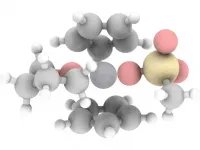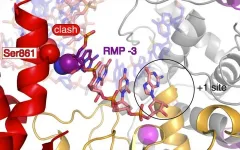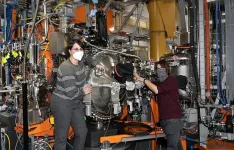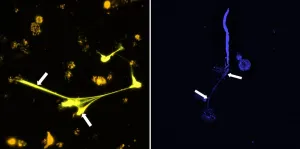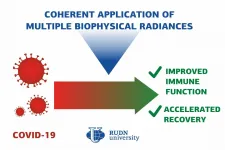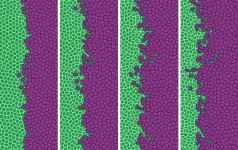(Press-News.org) Acetals are important chemical compounds that are used, for example, in the production of certain medical agents. A new method now makes their synthesis easier and more environmentally friendly. Chemists at the University of Bonn have developed and optimized the sustainable catalytic process. State-of-the-art computer simulations were also used. The reaction is based on a mechanism that frequently occurs in nature, but has rarely been used in chemical synthesis up to now. The results are published in the journal Angewandte Chemie.
The key step in the production of acetals is the bonding of two oxygen atoms to one carbon atom. Chemists often achieve this arrangement with oxidation. Strong oxidizing agents are normally used to accomplish this by releasing an oxygen atom during the reaction. The rest of the oxidizing agent must be disposed of after the synthesis.
"In our study, however, we describe a path that is referred to as atomic-economic, meaning that it does not generate waste," explains Prof. Dr. Andreas Gansäuer from the Kekulé Institute of Organic Chemistry and Biochemistry at the University of Bonn. "The starting molecule itself already contains the oxygen atom required for oxidation. The catalysis we have developed simply shifts this oxygen in the molecule, which creates the acetal."
The starting molecule contains a so-called epoxy group, a kind of "triangle" in which two corners are formed by carbon atoms and the third by an oxygen atom. Such triple rings are under great tension and therefore break apart easily at the oxygen atom. Epoxies store the necessary reaction energy like a compressed spring.
Catalysis based on the model of nature
To achieve this goal a suitable catalyst is required. Figuratively speaking, oxygen atoms have two "arms" with which they can form bonds. If the epoxy ring breaks, one of these arms becomes free. The catalyst now binds to it temporarily. This initiates a sequence of molecule-internal (intramolecular) rearrangements. At the end of this sequence, the oxygen atom releases the catalyst again and instead binds to the desired carbon. "This step is called oxygen rebound," says Gansäuer.
This mechanism has rarely been used in chemical syntheses to date - quite unlike in nature: The liver, for example, uses the "oxygen rebound" to break down toxins. This also requires catalysts, the so-called P450 enzymes. Their active center contains an iron atom. "The heart of our catalyst also consists of a common and non-toxic metal, namely titanium," explains Prof. Dr. Stefan Grimme from the Institute of Physical and Theoretical Chemistry at the University of Bonn.
Catalyst tuning on the computer
During acetal synthesis, titanium first absorbs an oxygen atom and then releases it again (oxidation is followed by a so-called reduction). This only works effectively if it binds the oxygen strongly enough to itself without "clinging" too much. In order to adjust its oxygen affinity appropriately, titanium is bound to certain molecules, its ligands. Depending on the binding partner, the metal then has a somewhat stronger oxidizing effect or can be reduced more easily. The most suitable "tuning molecules" are nowadays selected with the aid of a computer. The research group around Prof. Grimme specializes in this task: In recent years, it has developed algorithms that allow very fast simulations of catalyst properties.
This enabled the researchers in their study to optimize their catalyst so that it completely converts the starting material into the desired acetal. "The result documents very nicely how useful close cooperation between experiment and theory is for developing sustainable catalysis methods," emphasizes Gansäuer.
INFORMATION:
Andreas Gansäuer and Stefan Grimme are both members of the transdisciplinary research area (TRA) "Building blocks of matter and fundamental interactions" at the University of Bonn. Six different TRAs bring together researchers from a wide range of faculties and disciplines to work together on future-relevant research topics of the University of Excellence.
Funding:
The study was financed by the German Research Foundation DFG, with funds from the Gottfried Wilhelm Leibniz Prize and the Konrad Adenauer Foundation.
Publication: Pierre Funk, Ruben B. Richrath, Fabian Bohle, Stefan Grimme, Andreas Gansäuer: Oxidizing under Reductive Conditions: From Benzylic Ethers to Acetals with Perfect Atom-Economy by Titanocene(III)-Catalysis. Angewandte Chemie, DOI: 10.1002/anie.202013561
Contact:
Prof. Dr. Andreas Gansäuer
Kekulé-Institut für Organische Chemie und Biochemie
Universität Bonn
Tel. 0228/73-2800
E-mail: agansaeu@uni-bonn.de
Remdesivir is the first drug against Covid-19 to be conditionally approved in Europe and the United States. The drug is designed to suppress the rapid replication of the SARS-CoV-2 virus in human cells by blocking the viral copying machine, called RNA polymerase. Researchers at the Max Planck Institute (MPI) for Biophysical Chemistry in Göttingen and the University of Würzburg have now elucidated how remdesivir interferes with the viral polymerase during copying and why it does not inhibit it completely.
"After complicated studies, we come to a simple conclusion," Max Planck Director Patrick ...
UPTON, NY--Marking a major achievement in the field of spintronics, researchers at the U.S. Department of Energy's (DOE) Brookhaven National Laboratory and Yale University have demonstrated the ability to control spin dynamics in magnetic materials by altering their thickness. The study, published today in Nature Materials, could lead to smaller, more energy-efficient electronic devices.
"Instead of searching for different materials that share the right frequencies, we can now alter the thickness of a single material--iron, in this case--to find a magnetic medium that will enable the transfer of information across a device," said Brookhaven physicist and principal investigator Valentina ...
Scientists have discovered a molecule that can selectively kill cells of a hard-to-treat subtype of breast cancer, which could lead to a new therapy.
The study, led by researchers at RCSI University of Medicine and Health Sciences, is published in the current edition of Science Advances.
Triple negative breast cancer is a subtype of breast cancer which is mainly treated with chemotherapy. Unfortunately, up to 70% of patients with this form of breast cancer develop resistance to treatment.
The researchers tested different molecules to see if they could selectively kill the cells of this type of breast cancer while sparing normal ...
As hemp begins to reemerge as an important crop in the United States, scientists are beginning research into the diseases that might prevent the crop from flourishing. A study published in the December issue of Plant Health Progress is one of the first to study the potential disease and disorder limitations for hemp production in the southeastern United States.
Lindsey Thiessen, a plant pathologist at North Carolina State University, worked with colleagues to evaluate hemp samples from North Carolina and observed 16 different diseases. They found Fusarium flower blight most consistently followed by Helminthosporium ...
A new study published in PNAS finds that aid provided by the United Nations (UN) in the aftermath of climate-related disasters is driven by humanitarian need rather than by strategic donor interests. The results underline the importance of climate-related hazards for understanding aid disbursements.
The study 'Humanitarian need drives multilateral disaster aid' provides the first estimation of UN climate-related disaster aid worldwide. Although it cannot be entirely ruled out that powerful donor states' interests shape UN aid flows, the UN seems able to fend off donor states' strategic ...
Filariae, slender but sometimes up to 70 centimeters long nematodes, can set up residence in their host quite tenaciously and cause serious infectious diseases in the tropics. The tiny larvae of the worms are usually transmitted from person to person by mosquitoes, which pick up the larvae from the blood or subcutaneous tissue when they bite and deposit them in the vessels or tissues of their next victim. Researchers led by the University of Bonn (Germany) have now investigated a mechanism by which the immune system attacks the filariae. Certain immune cells, the eosinophil granulocytes, release DNA that forms a kind of web around the larvae and traps them. The researchers ...
Our brains experience significant changes in blood flow and neural activity during sleep, according to Penn State researchers. Such changes may help to clean out metabolic brain waste that builds up during the day.
"We studied the sleep patterns of mice during both rapid eye movement and non-rapid eye movement sleep stages, as well as in different alertness states," said Patrick Drew, Huck Distinguished Associate Professor of Engineering Science and Mechanics, Neurosurgery and Biomedical Engineering.
Mice were chosen for the study because of their brains' remarkable similarity with human brains, said the researchers.
In both mice and humans, non-REM sleep ...
A team of researchers from RUDN University and RLT suggested restoring normal levels of lymphocytes in patients with COVID-19 and other viral diseases by subjecting them to the combined influence of light, magnetic field, and ultrasound. The results of the study were published in the Journal of Photochemistry and Photobiology B: Biology.
Some COVID-19 patients are asymptomatic, while others suffer from complications. To effectively fight coronavirus with drugs and therapeutic methods, scientists and medics have to find out what causes these differences in the course of the disease. A team of scientists from RUDN University together with their colleagues from the international company Radiant Life Technologies (RLT) suggested that the reason might ...
A scientific study carried out by the Universidad Carlos III de Madrid (UC3M) and the Universidad Complutense de Madrid (UCM) has produced a mathematical description of the way in which a tumor invades the epithelial cells and automatically quantifies the progression of the tumor and the remaining cell islands after its progression. The model developed by these researchers could be used to better understand the biophysical characteristics of the cells involved when developing new treatments for wound healing, organ regeneration, or cancer progression.
This research analyses the collective ...
An Academic Analytics Research Center (AARC) study has found greater rates of authorship of open access (OA) research articles among scholars at more prestigious institutions with greater access to resources and job security. "The open access publishing model is growing, and open access successfully democratizes the results of research projects, but it's clear now that some scholars are more likely to be represented in the open access literature" said AARC director and lead author of the study Anthony Olejniczak, Ph.D.
The researchers analyzed characteristics of 182,320 open access authors at American research universities from 2014 through 2018. The study ...
